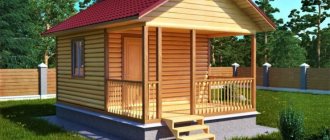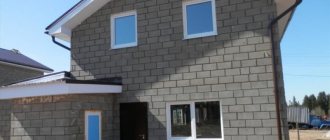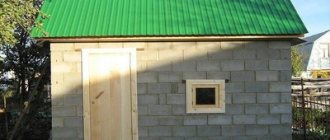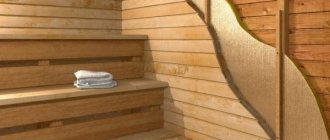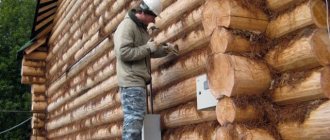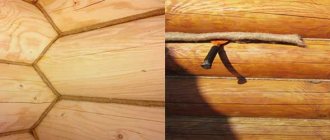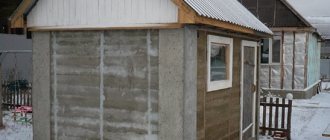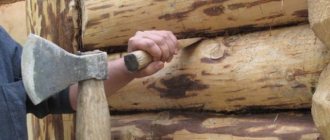The advantages of foam blocks traditionally include lightness, fire safety, long service life and low cost. The successful combination of the characteristics described above turns it into one of the most common options when it comes to choosing materials for a bathhouse. It is built in the shortest possible time and does not require significant financial investments. At the same time, the properties of the material and, first of all, its porous structure are vulnerable to cold and moisture.
In a bathhouse, given the specifics of the application, this requires additional insulation. The procedure is no different in complexity; you can order it from specialists or, after familiarizing yourself with the main points, perform it yourself. Careful work will be the key to a constant microclimate in the room, guaranteeing people warmth and comfort.
Features of insulating a bathhouse made of foam blocks from the inside
The need for additional thermal insulation measures is obvious. Despite the fact that foam blocks are a material that retains heat quite well, it can freeze in severe frosts and not provide the room with the necessary comfortable temperature. And for a bathhouse, maintaining heat inside is a very important point.
Insulation of walls in a bathhouse made of foam blocks from the inside has its own characteristics. This is primarily due to the fact that this material has a porous structure into which moisture can easily penetrate. Lingering inside, it can not only significantly reduce the ability of thermal insulation, but also affect the durability of the structure itself.
Advice. In addition to insulation, use waterproofing materials. This applies to both auxiliary premises and the steam room itself.
The most popular waterproofing material is membrane film or isospan.
As for insulation materials for insulating walls from the inside, the following most popular types can be noted:
- Mineral wool - the material is excellent due to its resistance to high temperatures, withstands heating up to 1000 degrees. That is why it is popular for insulating walls directly in the steam room. Mineral wool is durable and not susceptible to rotting and the formation of mold and fungi.
- Jute felt is great for insulating the walls of a bathhouse from the inside. This natural material has high thermal conductivity and is also able to remove excess moisture from the room. Not susceptible to fungi and mold. Also suitable for insulating a steam room from the inside.
- Foil insulation is a specially developed material for insulating walls and ceilings in saunas and baths. It is great for insulating a steam room. Its main advantage is the possibility of installation without battens.
Glass wool and foam insulation are not suitable for insulating the walls of a bathhouse from the inside, since these materials are not able to withstand high temperatures, and can also release toxic substances when heated, which will in no way help maintain a healthy microclimate.
We carry out calculations
In order to more accurately determine the need to insulate foam block walls with your own hands, it is worth carrying out calculations. During them, we will determine the resistance of the walls to heat transfer and compare it with the indicator required for our climatic zone.
As an example, consider the case when a house is built from blocks with a density equal to D500. The thermal conductivity coefficient of such products is 0.14.
Knowing this, we will divide the thickness of the product - in our case it is 375 mm, by this coefficient. As a result, we get a figure equal to 2.67.
Next, we open SNiP number II-3-79, which is called “Construction Heat Engineering”. In this document we find a standard indicator corresponding to our region. For Moscow it will be equal to 3.2. This means that the thickness of such walls will not be enough for high-quality thermal insulation of residential premises.
But our calculation instructions do not end there. There is one more point here that cannot be ignored.
If the obtained figure is still lower than the required one, then it is necessary to carry out insulation. We'll talk about it now.
Features of different materials for insulation
Bathhouse premises are divided into types depending on the internal microclimate. The washing room, steam room and combustion chamber have high humidity and temperature, and the rest room and dressing room have normal conditions.
The following insulation is used for bathhouse premises:
- jute felt;
- mineral wool;
- expanded clay;
- Styrofoam.
The materials are intended for different rooms, because... differ in properties and characteristics. When choosing, the hydrophobicity of the insulation and the ability to release harmful substances when heated are important.
Jute felt
Jute felt
Natural fiber from the plant of the same name is used in production. Natural resins protect the threads from rotting; the material is durable, environmentally friendly, and has a uniform density throughout the mass. Polyester fibers are used for bonding, which impart elasticity.
The peculiarity of jute is that when it is hot, it does not release toxic substances into the surrounding space. Requires film vapor and waterproofing, since the fibers get wet when in contact with moisture.
Mineral wool
Mineral wool
For production, rocks, glass, and blast furnace waste are used, which are melted in high-temperature chambers and form fibers.
There are different types of mineral wool:
- glass wool;
- stone wool;
- slag.
Glass wool absorbs moisture less than the other two types, but is also used in bath rooms in combination with steam protection. Mineral wool reacts steadfastly to the action of chemicals and, in the event of a fire, forms a barrier to the spread of flame. Getting wet reduces the heat-shielding properties.
Expanded clay
clay
Porous insulation is made from clay shale as a result of firing. Subsequent processing results in material with different bulk densities. Expanded clay can weigh from 150 to 850 kg/m3.
Environmentally friendly insulation is divided depending on shape and size:
- crushed stone;
- gravel;
- sand.
The first two varieties have a large, medium and small fraction. Sand and small-sized elements are not used to insulate a cinder block bathhouse from the inside, because... Due to the high density in the mass, it conducts internal energy faster. Large and medium granules are used, which require the construction of a special frame into which the material is poured.
Styrofoam
The material belongs to the group of foamed polymers. Gas occupies a large volume in the mass, so the structure contains isolated balls glued together during the production process. Thermal insulating properties are due to the low conductivity of the internal elements.
Polystyrene foam is well suited for insulating a bathhouse made of blocks from the inside with your own hands, because... Easily mounted on walls and does not require a frame. The material is inexpensive, but provides effective insulation from the cold. Polystyrene foam does not absorb moisture well and retains its properties for a long time.
Glass wool
Glass wool is inferior to basalt wool in thermal conductivity. Internal insulation of bathhouse walls is impossible with it, because... glass wool cannot withstand heating above 400 degrees. In addition, when this material wears out, it begins to emit an unpleasant odor, which is completely unacceptable for a bathhouse.
Laying rules
In order for such material to fulfill its tasks, it is necessary:
- ensure the best possible tightness of seams and joints;
- make sure there is a ventilation gap between the foil and the finish.
You can either buy metallized tape and glue the joints from the outside, or double-sided tape and fasten the panels together.
It will probably not be possible to create a complete seal of the seams and the entire material to protect against steam, but you can significantly reduce the amount of steam entering the insulation. To do this, the panels are laid with one over another by several centimeters (5-10 cm).
The joints are glued either with double-sided tape, which allows you to tightly fasten the two panels, or with special foil tape, which is sold in the same place where the foil material is sold.
It is equally important to maintain its integrity when installing a foil vapor barrier. In those places where the film is attached to the bars, holes form. Minimal damage during installation is ensured when using staples from a construction stapler. For those who love perfection in everything, you can additionally cover the places where they are attached with tape on top.
The second good way is to fix the panels with wooden clamping strips, into which nails are driven at intervals of 150-200 mm. Here the protection against steam penetration is immediately improved.
This gap is provided by the counter-lattice bars, to which the lining is subsequently attached. The gap size is at least 2 cm. Having selected the appropriate bars, nail them on top of the vapor barrier. And already attach the lining to them. When fixing it, do not forget about the need to maintain the integrity of the foil.
What happens as a result: part of the rising steam condenses on the vapor barrier film. Hanging droplets are dried by a flow of air that passes between the film and the lining. If everything is done correctly, there are no problems with rotting.
The gap between the vapor barrier and the finishing is provided by counter-lattice bars
The process of finishing interior walls with clapboard
Many people perform cladding using wooden lining. The advantages of wood are obvious to everyone - it is durable and beautiful, but when using it, all the nuances must be taken into account. For example, lining made from coniferous trees cannot be used where temperatures are always high, that is, in steam rooms, since when it is heated, sticky resins are released. They are dangerous to the human respiratory system. Quite often mold forms in bathhouses.
Antiseptics of various types help to cope with this, so it is better not to decorate the washing room with clapboard. Cheap pine paneling is used in dressing rooms. Deciduous trees are needed in the steam room. The most reliable and durable oak lining. However, currently aspen lining is most often used.
By all accounts, aspen is the best type of finish. The advantages are aroma, environmental friendliness, and health benefits, because when heated, some wood species release phytoncides into the environment.
Move the lining into the bathhouse itself - it should absorb excess moisture.
Before installing the finishing, complete the wiring of all communications.
Next, you need to make a wooden sheathing (for this it is better to use special screws intended only for working with foam blocks) and then everything is covered with a special solution that prevents the formation of mold.
Next, the insulation is installed. The vapor barrier material is attached with a stapler to the sheathing previously prepared for this.
Next, the lining is secured either with nails or secret clamps. Claypers are used at the finishing and decorating stage.
How to insulate a bathhouse made of foam blocks
The main task of a bathhouse is not only to create good steam, but also to keep it inside for a long time. This is especially true for a material such as foam block, which, without proper insulation, willingly gives off heat both inside and outside the room, which leads to rapid drying.
It is noteworthy that the process of insulating a bathhouse begins simultaneously with construction, from the foundation. It is recommended to use only those materials that are resistant to moisture, tolerate temperature changes well, and are difficult to break down biologically.
What to do to prevent heat from escaping through the walls
Carrying out work to install thermal insulation on walls is the main part of the insulation process.
For log houses
When working with wooden walls, you need to keep in mind that shrinkage will occur
You need to pay special attention to the crowns, because of this, cracks can form there through which air can freely pass. In such cases, an effective solution would be to use jute fiber
Its use is beneficial because it does not rot and has good thermal insulation properties. In its pure form, jute fiber is not strong enough. Therefore, manufacturers add flax fibers to it.
This material is sold in roll form. When building a wooden wall, it is laid between logs, or an already assembled frame is caulked.
When the walls are ready, material is compacted at the joints.
The log house can be insulated both outside and inside the room.
For a bathhouse built of brick or foam blocks (also applicable for wooden walls).
One of the ways to insulate the walls of a bathhouse from the inside with your own hands is as follows. In this situation, work is carried out from the outside. To do this, install the frame of the curtain wall with insulation.
The same method can be used for a structure made of expanded clay blocks. In this case, the material used is placed directly against the wall, leaving it under the lining or siding. The casing is designed in such a way that there is free space inside for ventilation. It not only ensures the safety of the insulation, but also serves as another layer of thermal insulation for the steam room. In addition, this prevents the appearance of condensation on the walls due to the large temperature difference between the wall and the surrounding air. In the same way, the insulation of a bathhouse made of expanded clay concrete blocks is done from the inside.
There is another way of insulation. A wooden steam room is built inside a room built of brick or foam concrete blocks. Timber is nailed to the internal walls and sheathing is installed. Mineral wool is placed inside as insulation.
Foil insulation is installed as the second layer. It is convenient to use lining for the finishing layer.
Insulation of a bathhouse made of foam blocks from the inside is carried out in the same way as for a brick building.
Bath insulation technology
To properly insulate a bathhouse made of foam blocks, it is necessary to cover all surfaces: floor, ceiling and walls with thermal insulation materials.
Floor insulation
You need to think about floor insulation even at the stage of building a bathhouse. To increase the protection of walls from groundwater, a layer of waterproofing should be laid between the foundation and the foam block masonry. Most often, ordinary roofing felt or similar materials are used for this.
Having erected the walls, you can proceed directly to the equipment and insulation of the floor. All work in this direction is as follows:
- The earthen base is leveled and covered with thick polyethylene in several layers. This is done to prevent moisture from seeping into the insulation layer.
- Then a layer of expanded clay, at least 10–15 cm, is poured in and compacted thoroughly.
- You need to make a cement screed on top of the expanded clay. In this case, you should use a reinforcing mesh, which can be placed directly on the expanded clay or buried in the thickness of the mortar during the process of pouring the floor.
- The top layer of the screed must be carefully leveled using a long rule.
After the cement screed has dried, the rough floor of the bathhouse is ready. Now it can be tiled with ceramic tiles or a wooden floor can be made.
Communications
Communications to the bathhouse can be carried out after the walls have been erected and the roof has been built. Before starting work, you need to study the features of laying electricity, water supply.
Electricity
Features of wiring:
- For a bath, it is better to use copper wires that have a protective sheath made of heat-resistant material.
- All switches and sockets must be brought into the dressing room.
- The wires should be hidden in a corrugated tube.
Lamps that will be installed in the bathhouse must be protected by sealed glass cases.
Sewerage
Features of sewer drain assembly:
- When assembling the floor, you need to make a slope in one direction so that the water flows down on its own.
- At the lowest point, install a grill over the drain point.
- Place the pipes behind the building into a drainage well.
Water supply
Water can be supplied to the bathhouse from a central water supply system, a well or a well. If pipes will pass along the surface of the earth, they must be protected with special warm casings. Additionally, you can attach a heating cord that will protect the pipes from freezing in winter.
Wooden floors
Wooden floors are insulated in a different way than concrete floors. For these purposes, more suitable polystyrene foam boards and foamed polymers are ecowool or Icing foam.
Insulation of wooden floors includes the following steps:
- The bars are ground to the very bottom edge of the main beams; they will be indispensable for constructing a subfloor.
- Pre-cut boards are laid between the beams on bars; the dimensions of these boards should be slightly smaller than the distance between adjacent beams. It is better to use low-grade wood for the construction of the cranial floor.
- A waterproofing membrane with a vapor-protective film is laid over the resulting layer; it should cover the entire area of the wooden floor structure. Expensive film can be replaced with sheets of roofing material with seams taped with bitumen mastic.
- Insulation is laid on this layer, on top of which the finishing floor boards are mounted and baseboards are installed.
Reinforced belt, ceiling beams, rafter system
“Shock” joining of walls made of building stone is carried out after completion of masonry work. On the last, top row of blocks, one three-dimensional reinforcement frame is laid, common to all load-bearing walls. It consists of two pairs of working rods (at least 1 cm thick), rigidly fastened with wire every 30 cm in length.
Then the space around the reinforcement is put into formwork and filled with cement-sand mortar.
After the concrete has hardened, the formwork is removed and the installation of the attic floor begins on the formed monolithic reinforced concrete element - a tying reinforced belt, without fear of loading the block masonry unevenly.
Wooden beams (section 10 × 10 cm) are laid along the entire sub-rafter belt, fastened into a single continuous mauerlat. It will support the attic floor beams and the rafter system (lower purlins).
The wall beams are attached to the reinforced belt with pins and are in contact with the concrete through roofing material and a layer of coating waterproofing. You can make nests under the Mauerlat in the armored belt.
The wider the span between the outer supports, the more snow falls in winter, the more powerful the roof structure should be: thicker the boards (beams), the smaller the pitch between the rafters. If the distance between the walls does not exceed 3 m, then 5 × 12 cm boards are suitable for floor beams (installation on edge).
To protect the walls with overhangs, the attic floor beams extend 30–50 cm beyond the perimeter of the bathhouse. The wood is impregnated with an antiseptic, and in places of contact with concrete they are wrapped with roofing material (leaving the ends open).
The author of the following video report shares a method for installing a roof in a small block bathhouse.
The rafters are covered with coniferous boards 4–5 cm thick, well dried, not knotty, and without cracks. The rafter legs, tie-rods, and slopes are connected with nails. Cuttings are made at the junction of the posts and the ridge girder.
A solid wooden flooring or sheathing is laid along the rafters, depending on the degree of flexibility of the roofing material.
A false ceiling is mounted below on the floor beams. The ceiling can also be laid on a rafter frame.
If floor beams are embedded in walls, then the minimum permissible embedment depth is 10 cm. Heated bath air should not penetrate into the fastening points: it will condense on colder elements and cause wood rotting.
A roofless ceiling with one gentle slope is made for a bathhouse with a total area of up to 12 m2.
The more spacious bathhouse is crowned with a gable roof. the presence of an attic requires a slope of 10–30 degrees (depending on the type of roof).
Concrete floors
If you decide to pour a concrete floor, then the bottom slabs or subfloor on the ground are thoroughly protected from the harmful effects of moisture. For these purposes, you can use rolled material in 1 layer or coating mastic in 3-4 layers. An alternative is to combine these types of waterproofing materials, after which the selected insulation is installed. If it is expanded clay, then it can also be mixed into the concrete screed. By the way, you can also insulate it with a layer of 25 cm of foam concrete of lower density. A reinforcing mesh is mounted on the installed insulating layer, this is done to prevent destruction of the concrete coating. After strengthening the floor, a concrete screed is laid on the reinforcement frame. The finishing coating depends on the wishes of the owner of the future bathhouse.
Ceiling insulation
Without reliable thermal insulation of the ceiling, it is impossible to properly insulate the bathhouse from the inside. More than 90% of thermal energy rises to the ceiling and evaporates. There are two methods for insulating the ceiling:
- The first method requires the use of foil, which is placed on the ceiling of the bathhouse from the attic side. Then the foil is covered with a layer of waterproofing and the entire space between the rafters is filled with fine expanded clay. Then the expanded clay is covered with another layer of plastic film on top and the roof can be installed.
- The second method is more suitable for a bathhouse with an attic. In this case, instead of expanded clay, you can fill the ceiling with clay mixed with sawdust. The effective layer of such coating is 20–25 cm.
Wall insulation
In order to properly insulate the walls of a bathhouse from the inside, it is necessary to use frame technology:
- Wooden sheathing is mounted on foam block walls.
- A layer of waterproofing material is installed.
- Insulation is being installed.
- Then you need to install another layer of vapor barrier.
Advice! To increase thermal insulation properties, it is best to choose a vapor barrier material based on foil. This will shield thermal energy, thereby reducing heat loss.
Based on the above material, it is quite easy to insulate a bathhouse. A distinctive feature of such work for a structure made of foam blocks is the use of a large amount of waterproofing material. A properly insulated sauna will last a long time and bring a lot of positive emotions.
Attic insulation
To insulate the attic, you can use mineral wool.
If the bathhouse is built with a technical upper floor, it is insulated along the covering, walls and slopes.
Materials used for the horizontal layer:
- slag;
- expanded clay;
- felt;
- Styrofoam.
Insulation of walls and ceilings in the attic is done according to the insulation scheme for similar surfaces in the bathhouse.
Types of suitable insulation materials
In our opinion, it makes sense to divide the types of thermal insulation materials for baths into sheet, roll and backfill. In addition, there are insulation materials that are applied to the walls in the form of foam or a moistened mass - these are polyurethane foam and ecowool, which are sprayed using special equipment.
Mineral wool can be purchased in rolls or sheets. It all depends on its density and the binders used.
BY THE WAY! We rarely name specific brands, but do you understand that the names Rockwool or Isover hide the same mineral wool produced by different companies?
Basalt wool is a type of mineral wool, a literal reference to the similar mineral used. There is practically no difference.
Basalt wool for baths
But you shouldn’t confuse mineral wool and glass wool - these are different insulation materials, made from different materials and with different properties.
Glass wool should no longer be used anywhere, because it is extremely unpleasant for humans - if it gets on the skin, it causes itching, and it is hazardous to health if it gets into the eyes or respiratory organs. Yes, and fiberglass crumbles during operation, turns into dust, and it penetrates through the cracks, and you breathe it.
Does not like fiberglass insulation and elevated temperatures typical of a bathhouse.
Polystyrene foam and extruded polystyrene foam are good insulation materials, especially the latter, but using them in a bathhouse is dangerous. They are absolutely not suitable for a steam room, but could (theoretically) be used in other rooms, but we will not recommend them, since they are a fire hazard.
ADVICE! In the bathhouse, polystyrene foam and penoplex can be used in floors under concrete screed - there they do not pose any danger.
So, sheet insulation is mineral wool, foam glass (excellent, but expensive insulation), calcium silicate and magnesium silicate sheets, non-recommended polystyrene foam and extruded polystyrene.
Foam glass
Roll insulation is again mineral wool (lower density), glass wool. foamed polyethylene, with or without foil (penofol, isolon, etc.).
We have already spoken about fiberglass, now about foamed polyethylene. It is often used as additional insulation in residential buildings, but polyethylene does not tolerate high temperatures, so it should not be used instead of foil to insulate a steam room.
Foil insulation Penofol
IMPORTANT! Polyethylene already melts at a temperature of one hundred degrees. By the way, it supports combustion.. In general, it is quite possible to insulate other rooms of the bathhouse with it (as a second layer)
In general, it is quite possible to insulate other rooms of the bathhouse with it (as a second layer).
We will divide bulk insulation for baths into those that can be moistened and “glued” to the wall, and those that cannot. Expanded clay and vermiculite belong to the second category, ecowool - to the first.
Expanded clay and vermiculite can be used to insulate floors and ceilings, where they adhere perfectly and retain heat indoors. In order to insulate the walls of a bathhouse with them, it is necessary that between the two layers of the main wall material there is a gap, a cavity that can be filled with insulation.
Expanded clay
Ecowool is waste paper (cellulose) crushed into dust, impregnated with fire retardants so that it does not support combustion. And it really doesn’t support it - this is a good material for insulating baths where it is on sale. Ecowool is used in dry and wet form. In dry conditions - for insulating floors and ceilings, as well as for filling cavities. When wet - for application to walls.
Insulating the roof with ecowool using the wet method. Cromwell Photos
Also on our website you can read two articles that provide a more complete overview of insulation materials that can be used in a bathhouse:
- review of bath insulation;
- choosing the best of natural and artificial insulation for a bath.
Insulation of washroom and rest room walls made of foam blocks
Insulation of other rooms of a bathhouse made of gas blocks can also be done with basalt wool or expanded polystyrene 100 mm thick.
Unlike a steam room, these rooms do not require resistance to high temperatures, so polystyrene foam may be a good choice.
The advantages of insulation made from this material include:
- resistance to getting wet;
- resistance to the spread of mold and fungi;
- high thermal characteristics.
Expanded polystyrene is laid between bars having a thickness equal to the thickness of the insulation, from which a frame is made on the inside of the walls made of foam blocks, on top of which a foil hydro-vapor barrier is spread, the joints of which are carefully sealed with metallized tape.
Completion of work
When building a bathhouse from foam blocks, it is extremely important to insulate the floor. Usually the foundation itself is laid with mineral fiber mats. An air gap is also created here between the blocks, from which a ventilation pipe comes out.
From the inside, the floor of the bath structure is insulated with mineral wool or expanded polystyrene and must be equipped with a heat reflector - foil film or polystyrene foam.
The gaps between the blocks are filled with expanded clay, which allows for even more insulation of the floor and at the same time has an air gap necessary for additional ventilation.
Insulation of the walls, ceiling, roof and floor of the bathhouse is carried out according to the general principles of thermal insulation. All seams, joints, and cracks in the insulating material must be sealed. Window openings and doors are small in size, and the windows are given a horizontally elongated shape. All this allows you to maintain as much as possible a constant high temperature and (if desired) humidity inside the bath.
Finishing the bath from the outside
Due to the fact that we already have the necessary wooden frame, all we have to do is find high-quality material for the exterior decoration of the bathhouse. Only after this the insulation of the bathhouse can be completed. Most often, wooden lining is used for the external cladding of bathhouses in Russia.
Example of façade cladding with clapboard
In conclusion, to all of the above, it would not be superfluous to pay attention to interesting and useful advice from experts.
Video description
This video describes and shows how to properly make insulated ceilings in a two-story bathhouse in different rooms:
To insulate the ceiling in a bathhouse, basalt or stone wool is often chosen.
Rigid basalt insulation boards Source izolux-volga.ru
A thickness of slabs or sheets of 5 cm is sufficient for a temperate climate. But most craftsmen recommend doubling the height of the thermal insulation layer. The mats are laid in 2 rows with offset and overlap of previous joints.
Insulation options are also used to create a seamless barrier. This is ecowool, polypropylene foam or expanded clay. Sawdust is considered a proven alternative.
If you decide which vapor barrier for a bathhouse ceiling is better, then experts give preference to metallized samples. This is justified by the fact that warm air tends to escape through the upper areas of the premises. Many craftsmen recommend using mineral wool with aluminum foil.
It is worth mentioning that the insulation on the attic side also needs protection. This applies to natural precipitation that can penetrate into the premises. The problem with mechanical load is also solved. Solutions - moisture protection and rigid flooring made of boards or sheet materials.
Plank floor in the attic Source sense-life.com
Tips and tricks
- First of all, do not forget that heated air masses can exit the bathhouse through the windows. And for this reason, you should give preference to small windows. What is also important, experts recommend, if possible, installing frames with more than one double-glazed window. And it is best to have 2 or 3 double-glazed windows (the more, the better, because this will prevent the rapid evaporation of warm air from the bathhouse).
Small window in the bathhouse - photo
- Doors and thresholds have an important influence on the thermal insulation in your bathhouse. Quite often, specialists are contacted with the problem of rapid evaporation of air from the bathhouse. And the reason for this in 90% is the gap between the threshold and the door, due to which all the heat evaporates. To be sure that you will not encounter a similar problem, it is best to install low doors with a high threshold.
It is recommended to install small doors with a high threshold
- Due attention should be paid to the heater. After all, the intensity of heating the bath and how long the warm air will be retained in it will directly depend on the heat capacity of the stones.
Stove-heater
What does it look like
Foil vapor barrier is the best choice for a steam room. If this is a regular vapor barrier, it is a milky, white, blue film.
There are them “checkered” with reinforcing fibers, and there are homogeneous ones. They feel dense to the touch and can have surfaces of different textures - smooth and rough. There are vapor barrier membranes. They are nonlinear - they have a corrugated surface or with spiked protrusions. Especially for baths and saunas, vapor barriers with a heat-reflecting coating are produced: it can be made of foil or metallized lavsan.
